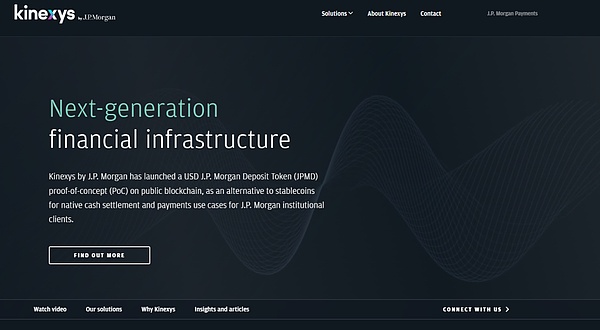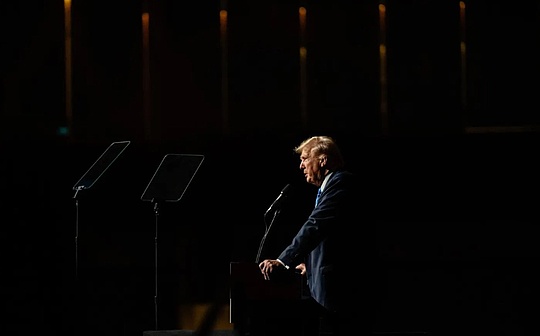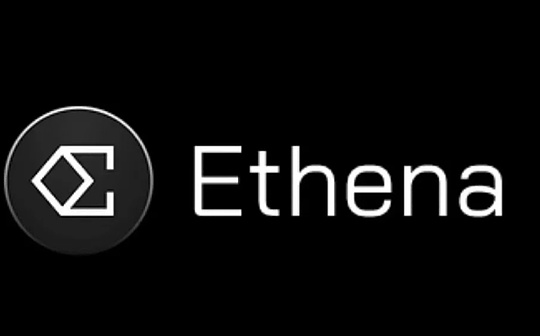
JPM Coin is a USD-backed stablecoin announced by JPMorgan Chase Bank in February 2019. It is positioned as an institution-to-institution (B2B) payment tool. It is based on the Quorum Alliance blockchain developed by JPMorgan Chase and runs on the Interbank Information Network (IIN) interbank network developed by it.
According to 2024 data from JPMorgan Chase, the launched platform Kinexys has cumulatively processed more than 1.5 trillion US dollars in transaction volume, processing an average of more than 2 billion US dollars in transactions every day.JPMC has become the first stablecoin for traditional banks to achieve large-scale application, establishing a benchmark for financial institutions to embrace blockchain technology.

JPMorgan Chase CEO Jamie Dimon once had an ambivalent attitude toward cryptocurrencies, criticizing the speculative nature of cryptocurrencies such as Bitcoin, but also bluntly stating that “these financial technologies are smart and we must participate.”This contradictory statement actually reveals the strategic considerations of traditional financial groups in the face of technological changes – if they do not proactively deploy core businesses such as stablecoins, payments and accounts, they may be subverted by emerging technology companies.
The scale and growth logic of the stablecoin market
The current stablecoin market size has reached 225 billion US dollars, accounting for about 7% of the global encryption ecosystem (the global encryption ecosystem scale is about 3 trillion US dollars), and has achieved positive market value growth for 7 consecutive months, showing strong industry strength.
JP Morgan analyst Kenneth Worthington pointed out that stablecoins “may be a better form than fiat currencies.” Its digital and traceable features on the chain make it easy for self-custody and instant transactions, especially in cross-border capital flows. Compared with the traditional SWIFT system (which usually takes 3 days to settle), stablecoins can be received instantly and prioritized, highlighting the alternative value of “digital fiat currencies.”
Regarding future growth potential, the market has grown significantly: JP Morgan predicts that the scale may reach US$500-750 billion in the next few years, and optimistic expectations predict that it will reach US$2 trillion by the end of 2028.Considering that the ecology is still in its youth, the infrastructure construction cycle and the conservation mentality of young people exist, actual growth may be slower than optimistic expectations, reflecting the complexity and uncertainty of industry development.
Stablecoin layout in traditional banking industry
The traditional banking industry’s deployment of stablecoins is essentially a defensive innovation practice, and its core motivations are dual:On the one hand, it aims to resist the continued erosion of traditional payment services by Fintech platforms such as PayPal and Block’s Cash App; on the other hand, it aims to seize key entrances to institutional-level digital financial services through first-mover advantage..
This strategic choice not only reflects the banking industry’s adaptability to emerging technologies, but also reveals its deep considerations of maintaining market dominance.Different institutions have formed differentiated paths based on their resource endowments: JPMorgan Chase’s JPM Coin focuses on real-time payment scenarios between institutions, Citibank focuses on tokenized deposits and encrypted asset custody services, and Bank of America builds ecological synergy capabilities by participating in stablecoin-related businesses.
The formation of this differentiated competition pattern not only avoids homogeneous internal friction, but also enables the banking industry to form multiple coverage points in the field of digital assets.
Regulatory framework reshaping impact
The GENIUS Act (the Guiding and Establishing National Innovation Act for Stablecoins in the United States) was signed into law, marking the formal establishment of the regulatory framework for stablecoins in the United States.Through the dual design of “legal identity authentication + strict reserve mechanism”, this bill directly responds to market concerns exposed by the TerraUSD run crisis in 2022, laying an institutional foundation for the mainstreaming of stablecoins.
Core regulatory provisions:
1. Prohibit issuers from paying interest for stablecoins and clarify their “non-revenue digital cash” attributes;
2. Requires 1:1 reserve support, and assets are limited to US dollars, short-term government bonds and high-quality liquid assets;
3. Allow non-bank institutions, subsidiaries of insured depository institutions (IDIs) and state chartered entities to serve as issuers.
Among them, the “prohibition of interest calculation” clause has a key impact:On the one hand, it weakens the direct competition between stablecoins and bank deposits and monetary funds; on the other hand, it strengthens its functional positioning as a payment tool..
However, we have to see that the uncertainty about whether non-bank issuers can access the Fed’s balance sheet may expose them to liquidity risks similar to traditional shadow banks – it is difficult to quickly respond to run pressure in extreme cases.
The core competitiveness of banking stablecoins lies in compliance endorsement.Taking deposit tokens as an example, they rely on the mature liquidity management framework and regulatory compliance system of traditional banks, and have a higher credit foundation and risk controllability than stablecoins issued by non-banks.
The multi-dimensional impact of stablecoins on traditional financial markets
The impact of stablecoins on traditional financial markets is reflected in three dimensions: payment efficiency reconstruction, capital market settlement innovation, and systemic risk transmission. Its integration with financial technology is reshaping the underlying logic of traditional financial infrastructure.
at the payment level, the instant settlement feature of stablecoins has achieved a jump in efficiency compared to traditional ACH and SWIFT systems (which take several days), and JPMorgan Chase’s combination of AI technology and stablecoins further amplifies this advantage.
The transaction anomaly identification system developed by this institution is 300 times faster than traditional methods. Through the collaboration of real-time risk monitoring and instant value transfer, it promotes the real-time transformation of cross-border payment and settlement from “T+N” mode to “T+0” and reconstructs the efficiency boundary of financial infrastructure.
capital market level, stablecoins are exploring deep integration with AI-driven assets.JPMorgan currently manages $1.2 trillion in AI-related bonds, or 14% of the U.S. investment-grade bond market, and the dynamic valuation nature of such assets has created demand for real-time settlement tools.
Stablecoins can be applied to real-time collateral adjustment scenarios for AI bonds, such as algorithm-driven asset portfolio rebalancing, to achieve instant settlement of collateral value fluctuations and reduce counterparty risk exposure caused by traditional settlement delays.
risk transmission level, we need to be wary of the cross-market spillover effects of “run risk”.The 2022 TerraUSD collapse showed that the risk of a run on algorithmic stablecoins could trigger a chain reaction;
Although banking stablecoins rely on a 1:1 fiat currency reserve mechanism to reduce endogenous risks, large-scale centralized redemptions may still be transmitted to the traditional system through the financial market.
For example, the concentrated selling of short-term government bonds in the reserve asset pool may trigger a liquidity crisis in the bond market, which in turn affects the stability of the balance sheets of traditional banks holding similar assets, forming a transmission chain of “stablecoin runs – reserve asset sales – traditional financial market fluctuations”.
Stablecoins serve as a key bridge between traditional finance and web3, its core value has been fully demonstrated through scenarios such as payment efficiency improvement and cross-border flow optimization.Driven by the dual drive of the GENIUS Act regulatory framework and the integration of AI technology, the mainstreaming process is irreversible.
The role of traditional banks has profoundly changed, evolving from cryptocurrency skeptics to active participants. By issuing stable coins (such as JPM Coin) and exploring tokenized deposits, they not only defend against Fintech competition, but also seize the entrance to digital finance.





